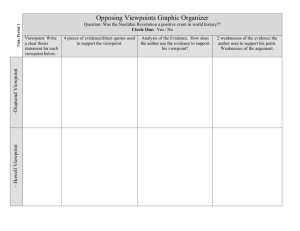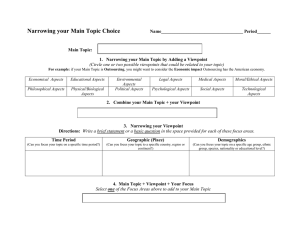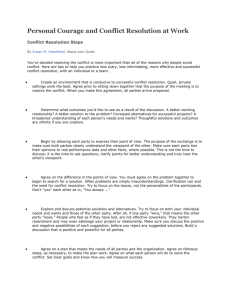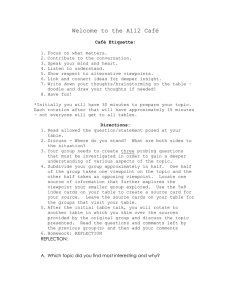Representation and Discovery of Vertical Patterns in Music Darrell Conklin
advertisement
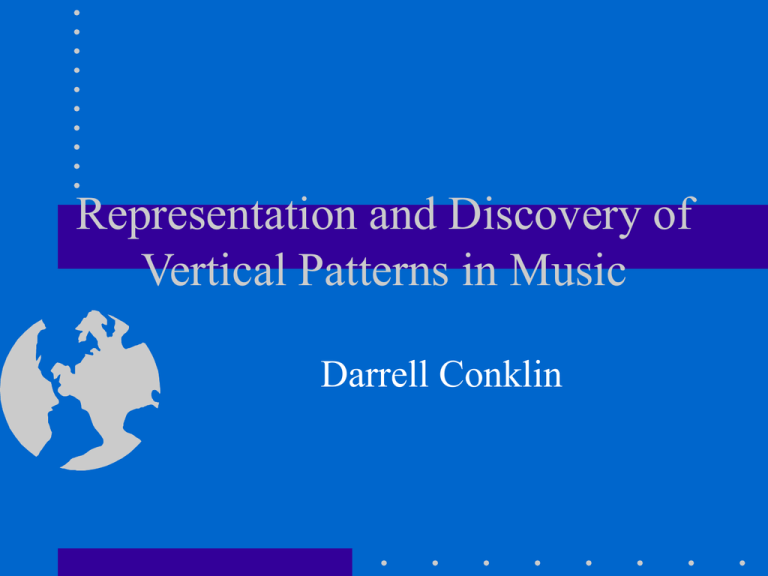
Representation and Discovery of
Vertical Patterns in Music
Darrell Conklin
Introduction
Need a representation method to be able to
manipulate and establish relationships
between sequences in a musical piece.
Identify recurrent patterns and ‘signatures’
using pattern discovery algorithm.
Application in synthesis and classification
of polyphonic pieces of music.
Terminologies
Music Objects: Notes, Simultaneities
(Sim), Sequences (Seq).
Note - MIDI integer defining pitch class
and octave.
Seq (X) - joining music objects of type X
that do not overlap in time.
Sim (X) - layering objects of type X which
have the same onset time.
Representation of Music Objects
Sim (Seq ( Note) )
< [ A, D, A, B, A, G, F#, F# ] ,
[ D, D, D, D, D, C#, D, D ] ,
[ F#, F#, G, A, G, F#, E, D, E, D, D ],
[ D, B, F#, G, A, A, D, D ] >
< > Sim object
[ ] Seq object
Structuring and Partitioning of
Music Pieces
Transformation from Sim(Seq) to Seq(Sim).
[ < [A,G], [D,C#], [E,D,E], [A,A] >,
< [F#], [D], [D], [D] > ,
< [F#], [D], [D], [D] > ]
Natural Partitioning creates new object
when all voices have same onset time.
Viewpoints
Viewpoint :
Seq (X) --------> viewpoint elements
Example :
Features of melodic segments- viewpoint of
type Seq(Note)
Feature lists(beat list, etc) - viewpoint
elements
What does a Viewpoint element
tell us?
Example :
viewpoint ‘t’ :t (join (c, o) ) = v
‘ music object o has the attribute value v in
the context of sequence c’ .
Viewpoint element of an object depends on
preceding objects in the sequence.
Viewpoint Sequences
Sequence ‘s’ = [s1, s2,…, sn]
Viewpoint ‘t’ applied to this sequence gives
a viewpoint sequence
[ t(s1), t(s2), …, t(sn) ].
[A,D,A,B,G,F#,F#] ---> [5,-5,2,-2,-2,-1,0] for
the melodic interval viewpoint.
Viewpoint Patterns
It is a recurring viewpoint sequence
fragment in a corpus of pieces.
P-value of a pattern that occurs ‘n’ times in
a corpus - Pr { pattern occurs ‘n’ or more
times in a random corpus of the same size.}
P[2,-2]< P*[5,-5,2,-2,-1,0]
Shortest & Longest Significant patterns.
Vertical Viewpoints
• Viewpoints can be linked together using a
constructor to form complex viewpoints.
• Viewpoint ‘F’ must be transposition
invariant F(X)=F(T(X)) .
• Viewpoint of type NOTE can be ‘lifted’ to
form vertical viewpoint of type
Sim(NOTE).
RESULTS
• 185 Bach chorales--> expanded-->> pitch
class interval viewpoint-->threaded at
quarter note beat and lifted.
• 32 shortest significant patterns covering 142
pieces were detected.
Shortest Significant Patterns
1
2
3
4
5
6
7
8
9
10
Pattern
[[2,10,11,0], [5,9,8,10]]
[[2,5,11,0], [5,2,8,10]]
[[2,11,11,0], [5,8,8,10]]
[[2,11,10,0], [ 5,8,9,10]]
[[4,0,0,11], [0,0,11,0]]
[[0,0,11,0], [ 5,9,8,10]]
[[2,6,11,0], [5,1,8,10]]
[[3,0,0,0], [4,0,0,11]]
[[5,0,2,10], [2,11,10,0]]
[[9,11,0,2], [0,10,0,1]]
p - value Coverage
0
36
5.00E-14
19
2.00E-11
19
2.00E-11
16
2.00E-06
15
9.00E-06
20
4.00E-05
7
2.00E-05
12
2.00E-05
10
2.00E-05
6
Scope For Thought
• Not effective on free-form MIDI data.
• A new representation method :
• Notes are encoded as multidimensional
vectors; repeated patterns in a piece are
geometric translations of these vectors.
• Expansion of pieces can distort tonal
harmony.

